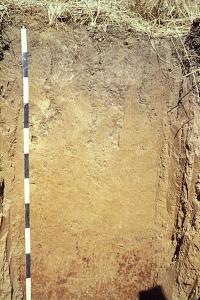Reference soil South Africa 12: Umbrisol
Umbrisols occur mainly in regions where precipitation exceeds considerably the evapotranspiration. They are dominantly associated with acid parent materials.
Characteristics
Soils having an umbric horizon (deep, brownish or blackish surface horizon with a significant accumulation of organic matter and low base saturation). They have no diagnostic horizons other than an anthropedogenic horizon less than 50 cm thick, or an albic or cambic horizon.
Reference soil ZA012: Umbrisols
PARENT MATERIAL: Derived from weathered paleozoic rocks: Middle Ecca Sandstone. ADDITIONAL NOTES ON PROFILE DESCRIPTION: Ah1 - top 5 cm: strong very fine subangular blocky/crumb,friable. Ah2 - mottles: soft iron concretions. B1 - plinthite; iron concretions: black; also many small and large, soft/hard, irregular and spherical, dark red (10R3/6) when broken and moist, red (7.5YR4/8) when broken and dry, iron-manganese concretions. B2 -also common strong red (7.5YR4/6, when moist) and few black mottles.
Classification
| WRB 2006 | WRB 1998 | ||||||||||||||
|---|---|---|---|---|---|---|---|---|---|---|---|---|---|---|---|
| Cambic- Umbrisol (Humic Hyperdystric Clayic Chromic) | Humi-Umbric- Plinthosol | ||||||||||||||
| |||||||||||||||
| FAO-UNESCO-ISRIC 1988 | FAO-UNESCO-ISRIC 1974 | ||||||||||||||
| Plinthi-Humic Cambisol | Humic Cambisol | ||||||||||||||
|
| ||||||||||||||
| Local classification: | Avalon Form, Woodburn Family |
